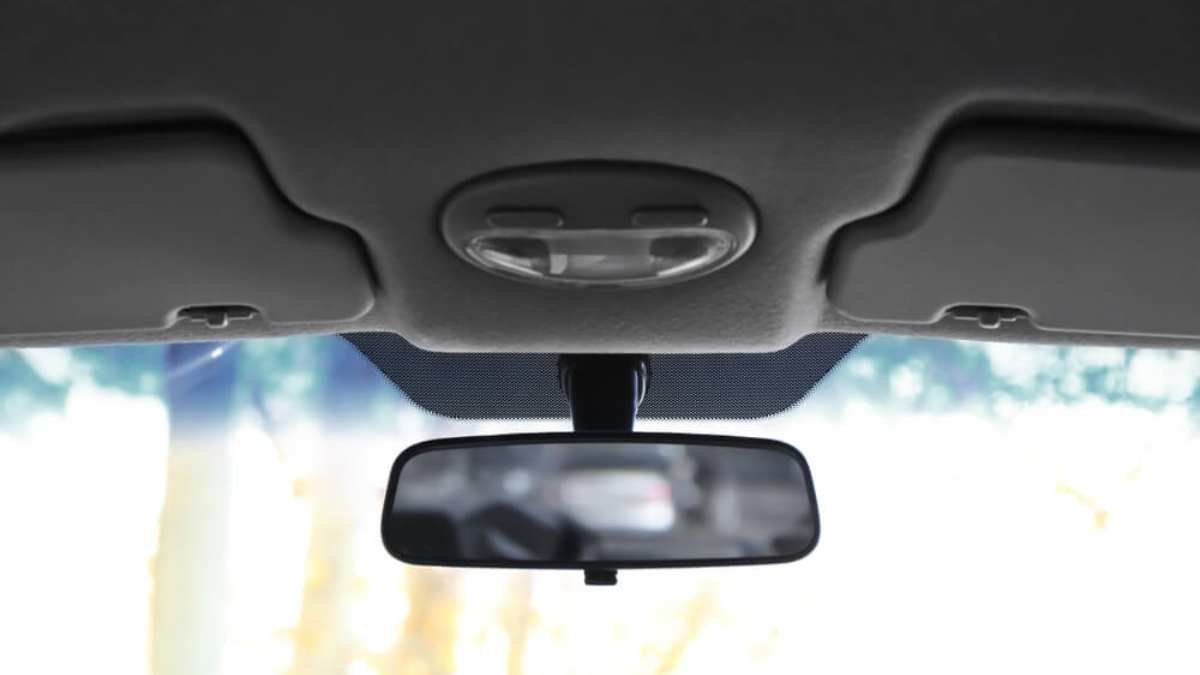Car headliner repair can be a simple, quick, and inexpensive DIY project. Learn five different methods.
No matter how well a car is made, something on it will break or stop working properly eventually. The headliner is one such part.
If you’re dealing with a sagging headliner, don’t worry. AutoTribute has you covered.
Not only will we provide you with ways to fix the headliner yourself, but we also explain just what exactly a headliner is or does, why it fails in the first place, and what you can do to maintain it. Let’s begin.
IN THIS GUIDE
What Is A Headliner?
With regards to automobiles, a headliner is a fabric or other composite material that lines the inside of a vehicle’s roof. It has several purposes:
- Headliners improve the appearance of the interior, giving your car’s otherwise dreary fiberglass or metal roof a soft, nicely textured, and colored surface that’s more appealing to the senses.
- They prevent the interior from getting too hot or too cold by providing insulation against outside temperatures. In other words, the inside of your car is kept cooler in the summer and warmer during the winter.
- Headliners improve the acoustics of the interior and make it quieter by absorbing outside noise.
- They act as a cushion against head impacts during collisions, helping mitigate injuries.
As you can see, car headliners contribute a lot more to our driving experience and safety than they are often credited.
Why Do Headliners Fail?
A headliner is not a single sheet of fabric but rather a multi-layer composite material that’s glued to polyurethane foam, which in turn is glued to the inside of the car’s fiberglass roof.
The cause of a loose or sagging headliner has less to do with the composite material and almost everything to do with the glue that sticks it to the roof. The following variables are usually at fault:
- Old age. The glue deteriorates over time and becomes less effective at holding the headliner composite in place.
- Moisture. Exposure to any form of water, especially moisture, will cause the glue to moisten and dissolve, accelerating its deterioration. Humidity is a serious risk factor.
- Bad glue. While usually not the case, the adhesive might not be of good quality.
The headliner will initially start to sag as the glue deteriorates and then fall down completely if the condition gets very bad. Not only is a sagging or falling headliner a potential safety hazard that can cause you to fail a vehicle inspection, but the unsightliness of it will also reduce the value of the car.
Of course, you shouldn’t wait until things get that bad. Take action to repair your headliner once you see signs of deterioration.
How To Repair Sagging Headliner

Fixing a sagging headliner isn’t as difficult as repainting a car or truck — it’s fairly easy.
Now, before we outline the different ways a car headliner can be repaired, there is something you need to know: The only way a sagging headliner can be permanently fixed is to replace it entirely with a new headliner.
Unfortunately, a full replacement can be quite expensive, and I dare say you would prefer a more cost-effective alternative. You’re in luck!
While the following methods won’t deliver permanent results, they may improve the appearance of the headliner and eliminate any safety risk they pose for a duration of time.
1. Gluing
Using glue to stick the headliner back to your roof is perhaps the most obvious method; however, it’s not necessarily the easiest. It works best for minor repairs, particularly the onset of any sagging at the edges of the headliner.
Spotlight: The 10 Best Headliner Adhesive For Car Upholstery
Of course, you can’t just use any garden variety glue. You need one that’s purposely designed for reattaching loose vehicle upholstery and can withstand the rigors of driving, especially adverse weather conditions.
We have reviewed some of the best headliner adhesives on the market, and two of our favorites are the Permatex Body Shop Headliner Adhesive.
The process of using glue to reattach a headliner is very straightforward:
- Remove anything that could get in the way of the job (roof handles, clips, ceiling lights, etc.).
- Apply two or three light coats of the adhesive to both the backside of the headliner and the surface it attaches to, allowing about 5 minutes of dry time between each coat.
- After applying the last coat and allowing it to dry, press the fabric firmly against the roof to reattach it, making sure to smooth out any wrinkles.
- Reinstall any items that you removed in the first step.
2. Pinning
Pinning the headliner back in place is the cheapest, easiest, and quickest method since it only involves pushing the sagging headliner back on its foam backing board and securing it with pins.
While you can use thumbtacks and just about any other type of pin, we recommend using clear-head twist pins that are specially made for use with upholstery.
These special pins have a corkscrew design that provides a more secure hold than straight pins such as thumbtacks, not to mention their clear heads make them less conspicuous.
Twist pins are fairly cheap and can be purchased at any major retailer. The Attmu Clear Head Twist Pins are well-made and very popular.
3. Double-Sided Tape
Is there anything double-sided carpenter’s tape isn’t good for? Count car headliner repair as one of its many uses.
This method works particularly well for a headliner that’s sagging around the edges or is separating around the rearview mirror mounting.
Double-sided carpenter’s tape has very strong adhesive properties, and using it is very easy:
- Cut off the length of tape you deem necessary and attach the sticky side to the headliner fabric. You might need to attach several pieces.
- Peel the removable backing off the exposed side of the tape, and press the fabric against the roof to stick it in place.
If you’re looking for a quality roll of double-sided carpenter’s tape, consider the XFasten Double-Sided Woodworking Tape.
4. Steaming And Rolling
As noted earlier, headliners sag because the original glue that’s used to stick them to the car’s roof breaks down and loses its potency, either due to old age or poor maintenance. That’s where this repair method comes in.
Steam can be used to melt and rejuvenate the factory glue, returning some of its potency. However, it won’t do much if the glue has dried out too much and is too far gone to be “resuscitated.”
It doesn’t hurt to give it a shot, though. Get yourself a small steam cleaner and an unused paint roller, and follow these steps:
- Using the steam cleaner, apply steam over a small area of the headliner to “remelt” the glue. Excessive steam can shrink or even damage the headliner fabric, so don’t overdo the steaming.
- Use the paint roller to distribute the glue more evenly under the headliner and smooth out any wrinkles.
- If you notice that the glue still has some sticking power, proceed to treat the other sagging areas of the headliner.
5. Staples And Hairspray
Don’t be quick to dismiss this method for sounding outlandish — it actually works!
All you need is a stapler gun (a regular paper stapler won’t do the trick) and hair spray to get started. Once you have obtained them, do this:
- Staple the headliner to the roof backing board.
- Apply the hairspray over the headliner, and let it dry
- Once dry, remove the staples
The staples and hairspray method can be a cheap way to temporarily fix the sagging headliner in a car that’s too old to spend much money on.
Headliner Maintenance Tips
Even though the headliner in every vehicle will deteriorate over time, there are things you can do to slow down the degradation. Here are some practical tips for maintaining your car headliner:
Keep It Clean
Keeping the headliner as clean as possible is one of the best ways to mitigate its degradation. If left alone, dirt, stains, and other substances will seep into the adhesive used to attach the headliner to the car’s roof and cause it to fail prematurely.
Be gentle with the cleaning and keep it to small areas. Deep cleaning can adversely affect the headliner adhesive, so avoid it if possible.
Reduce Interior Moisture
Moisture is the bane of headliners, so do everything you can to prevent it from getting inside your car. Here are some of the things you can do to keep your interior dry:
- Remove or dry anything in the car that gives off moisture (wet carpet, seats, clothes, etc.).
- Leave some windows slightly open on warm, sunny days to circulate moisture out of the interior and allow the sun to dry its surfaces.
- Make sure all windows are closed on wet days to avoid water or moisture getting inside.
- Don’t keep garbage in the interior. Leaking bottles, liquid residue in cans, and rotting food can all create moisture.
- Check that the door seals aren’t leaking. Repair any breaks or tears.
- If your car has a sunroof, make sure that all its drain holes are unobstructed. Ditto for the lower windscreen panels.
- Park your car indoors whenever possible. An above-ground garage typically has a higher ambient temperature than outdoors, making it better for preventing dampness.
Headliner Repair FAQs

See if the answers to these popular questions about car headliners provide you with additional useful information.
Do You Need A Headliner In A Car?
Generally speaking, cars don’t need a headliner to run or even drive safely on the road. However, there are benefits to having one.
Headliners improve the appearance of the interior, provide insulation against outside temperature, absorb excess external noise, and provide cushioning for passengers during collisions.
Think twice before doing away with your falling headliner completely. Make an effort to repair or replace it.
How Long Does A Car Headliner Last?
Car headliners will generally last 10 to 15 years before deteriorating due to old age. The better maintained they are, the longer they last.
Keeping your headliner clean and free of moisture will prolong its lifespan.
How Much Does It Cost To Repair A Headliner?
It can cost anywhere from $150 to $500 to have a professional repair or replace a damaged headliner. Costs vary depending on the size and sophistication of the headliner, the severity of the damage, and where the repair is performed.
The cost is highest when the entire headliner has to be replaced.
Where Is A Cheap Place To Repair A Headliner?
The cost of repairing a headliner is partly dependent on where you go. It will usually be cheaper to get the headliner fixed at a mechanic rather than at a dealership, especially if the mechanic specializes in your particular vehicle and has all the necessary materials on hand.
Final Thoughts
Hold on to your car long enough, and you’re sure to eventually deal with a sagging headliner. That’s because the headliner is one part of a car that will fail no matter what you do, though proper maintenance will make it last longer.
But a sagging headliner isn’t something you have to live with. Depending on the type and severity of the damage, you may be able to repair it yourself using nothing more than a quality headliner adhesive, thumbtacks or twist pins, and/or double-sided specialty tape.
Steaming, although requiring a bit more effort, can also be a viable option.
Either way, car headliner repair doesn’t always require paying for the service of a professional. If you found this article useful, you might also want to know what license plate screw size to get for your vehicle, what a tire pressure sensor fault means, and how much it costs to replace tie rods.

